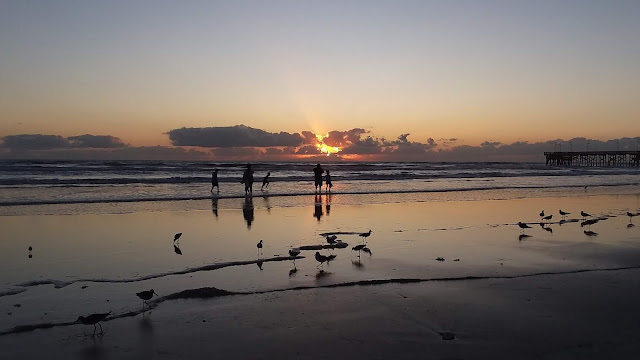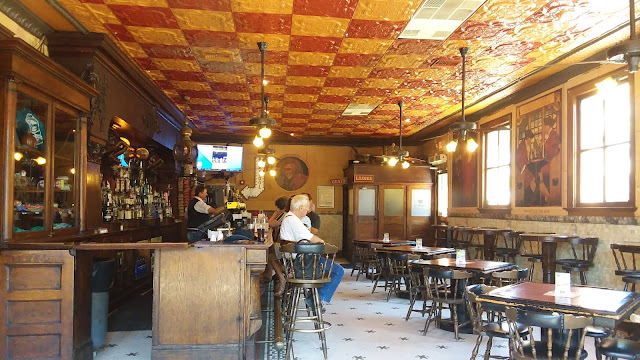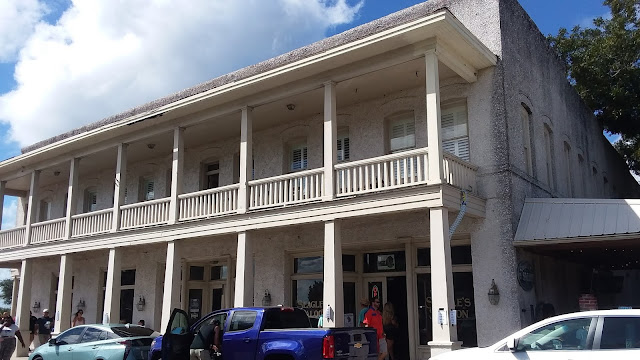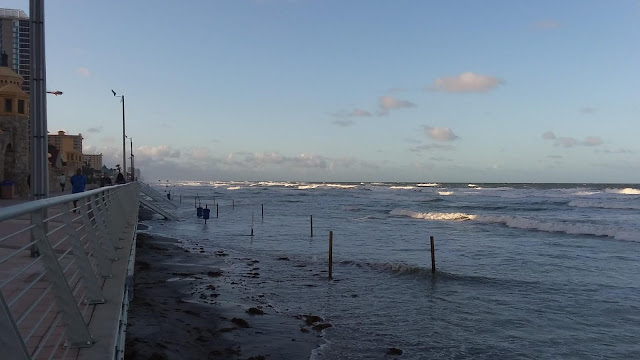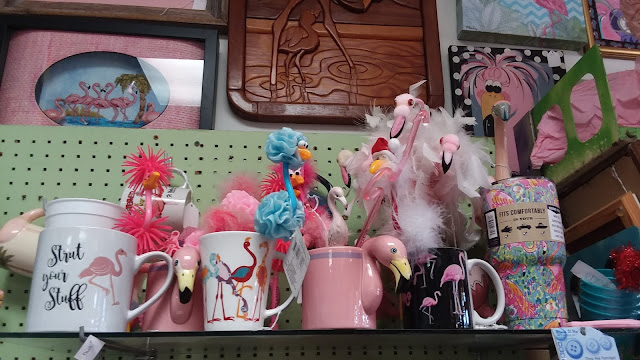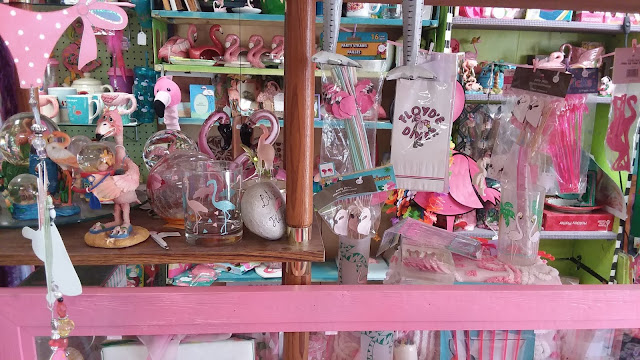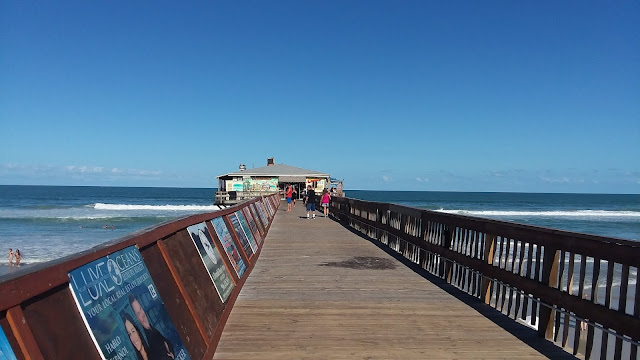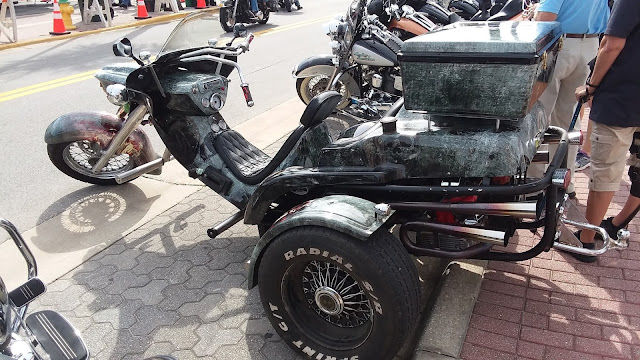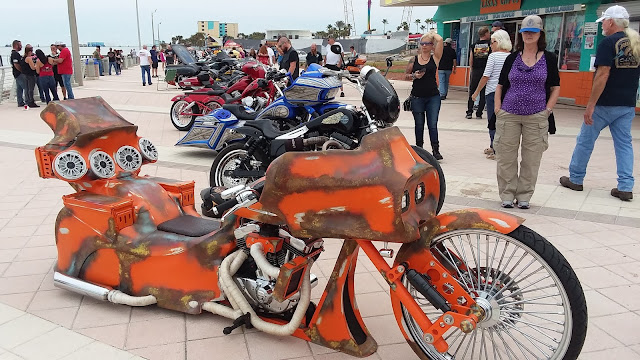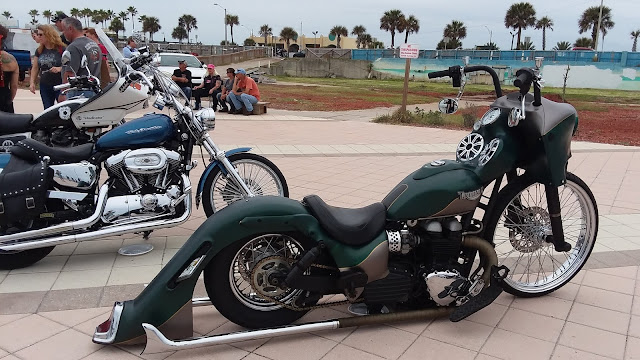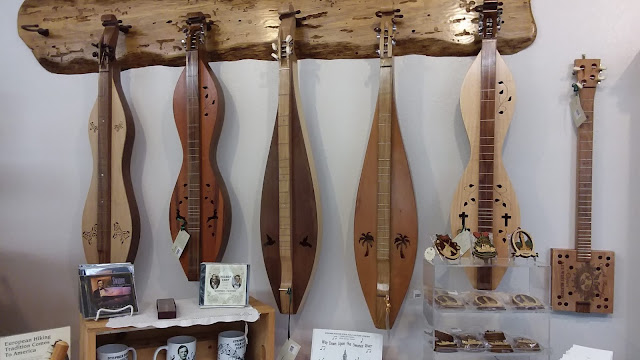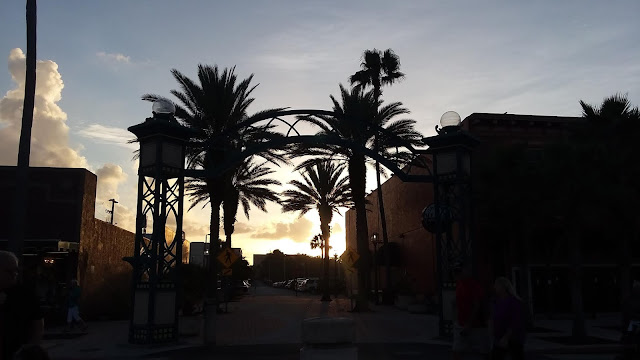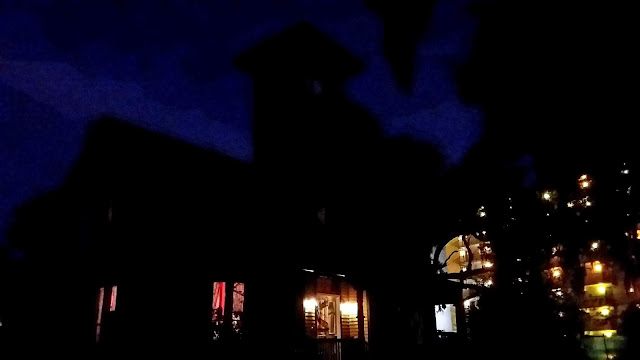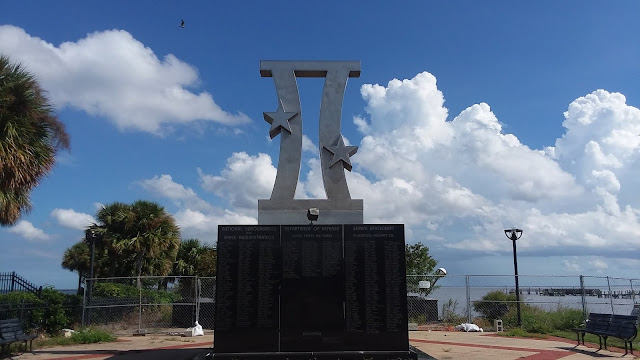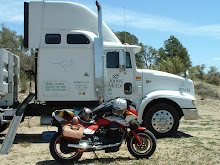I walked further north along the beach to Seabreeze Boulevard and the gates from the street to the beach.
2 October - early morning walk to the beach.
On this day, from the third floor of the Oceanwalk Shoppes - I noticed the reflection of the sunrise in the windows of the Wyndham Resorts offices. It may become a favourite photo spot.
This large dark cloud was in the west, between the buildings at Oceanwalk Shoppes.
Then it changed to one big cloud as I walked back to the house.
Wednesday afternoon, Jim and I drove to New Smyrna Beach and met Tim, Helena, Lamont and Mary Lynn for dinner at La Patron Mexican restaurant. We had not seen them for several months, and it was great to catch up for a lovely Mexican meal. La Patron is above a local bar. Caseys NSB Bar- the owner promotes and features a variety of musicians, and 8 Ball Aiken had performed there the night before and was playing again on this evening.
 |
| Caseys NSB Bar in New Smyrna Beach. |
We all left at the half break, the others had to work the next day, and Jim and I drove back to Daytona Beach.
3 October - early morning walk to the beach.
On 4th October, Jim and I left the house early - we had planned an overnight excursion. I snapped a couple of sunrise photos as we drove north along A1A.
Highway A1A through St. Augustine, over Lions Bridge.
 |
| Sights while driving in Florida - an air boat. |
Internet: Mayport is a small community located between Naval Station Mayport and the St. Johns River in Jacksonville. It is part of the Jacksonville Beaches community. The only public road to Mayport is State Road A1A, which crosses the St. John s River to Fort George Island.
The site is dedicated to the Huguenots who left France to seek religious freedom and to escape religious persecution. They were Protestants or Huguenots, in France and were seeking refuge in the New World.
On Friday, 1 May 1562 the first party landed in the New World on the east shore. In the presence of friendly natives, the Frenchmen fell to the ground and gave thanks to God in the first Protestant worship service held in the New World.
The St Johns River Ferry, also known as the Mayport Ferry, is an automobile ferry between Mayport and Fort George Island, two areas within Jacksonville. The ferry has been operating since 1874.
 |
| Lined up at the Mayport ferry. |
The ferry trip is about 10 minutes, and cost $7 one way, it runs every half hour. On Fort George Island, we could see the Naval Station Mayport across the river. On this day, the British aircraft carrier HMS Queen Elizabeth docked, with more than 1,500 sailors.
Distant, but across the river from the highway.
We were now on Amelia Island.
Internet: Amelia Island is part of the Sea Islands chain on Florida’s Atlantic coast. It has a history of Spanish, French, British and American rule. Today it is a popular holiday destination known for its luxury resorts, golf courses and numerous sandy beaches.
With 13 miles of beautiful beaches, abundant native wildlife, and pristine waters, this barrier island has long been a beloved destination of visitors and residents alike.
Fernandina Beach is the resort area.
We parked in the historic downtown area of Fernandina Beach village and walked around. Wow, there is a lot of history in this area.
| St Peter's Church (Episcopal). |
We parked at the waterfront (Amelia River). A big shrimping history out of here. It is where the St. Johns, Amelia and St Marys Rivers enter the Atlantic Ocean, and is known as the birthplace of the modern shrimping industry. The Shrimping Museum is an annexe of the Maritime Museum in the main street. The main-in-charge was Bob and he was interesting and gave us a lot of information. There are still a lot of shrimp boats operating out of the waterfront.
Internet: Native American bands associated with the Timucuan mound-building culture settled on the island, circa 1000, they knew it as Napoyca. They would remain until the early 18th century. Since then, the island has frequently changed possession and been under eight different flags – the only United States location to have done so.
Internet: The flags of the following nations have flown since 1562: France, Spain, Great Britain, Spain (again), the Republic of Florida, the Green Cross of Florida, Mexico, the Confederate States of America, and the United States.
'Bob' was the volunteer at the Shrimpers Museum while we visited and he gave us a lot of information on the area. Beach erosion is a huge problem and expense for Counties and City beaches and especially barrier islands. From 1 November to 31 March, the US Navy dredges the St. Marys river (the off season for turtle nesting and hatching), so the submarines and ships can enter and leave the US Naval Station Kings Bay. All the dredged sand is placed at nearby Fernandina Beach and Fort Clinch State Park, it is an ongoing solution to beach erosion. Bob said that often he looks out to the river to see a huge submarine cruising down the river. Wow!
 |
| I thought this slogan was great advertising! |
Many historic markers, and buildings in the village.
Florida’s first Atlantic to Gulf railroad - construction began in 1856 in Fernandina, and the final track to Cedar Key was laid in March 1861, and Florida had its first cross-state railroad.
Fernandina Observer, 12 May 2019: Located on the east side of the historic Train Depot Plaza, the garden features an array of plants selected to attract butterflies. The garden is set against a backdrop of a 3-D butterfly mural. The walk-way consists of original 1900-era bricks salvaged during a 1970s street redesign.
Amelia Island’s The Palace
Saloon is the oldest bar in Florida and was the last American tavern to close
during Prohibition. It survived that dry
era as an ice cream parlor. Once a
favourite haunt of the Carnegies, the Rockefellers and other socialites, The
Palace Saloon is still operating today.
Still in the original location, this watering hole’s colourful history
began in the late 1800s.
Originally constructed as a
haberdashery on 1878, in 1903 shoes were replaced with booze and named The
Palace Saloon.
Between 1880-1910, Fernandina’s
docks were among the busiest in the south.
Basking in her heyday, she welcomed ships from the far corners of the
globe. Of the many saloons that lines
the lively streets of the harbour district – there were over 20 at the time – only
one bore the distinction of being the “Ship Captain’s Bar”, and that was The
Palace.
According to local historians,
the owners of the Saloon were selling liquor until the very last minute before
Prohibition took effect.
We enjoyed cold beers in The Palace.
All original furnishings, except for a fire in 1999, the tin ceiling was replaced.

 |
| Original restrooms, it appears the "ladies' was an addition. |
After leaving Amelia Island, we had to drive around the St Marys River, because the next crossing was via Interstate 95.
At the second exit in Georgia, we booked a motel for the night, had a look at the town of Kingsland, then drove into St Marys township.
St Marys is a town in southeastern Georgia and is the gateway to Cumberland Island National Seashore, the largest of the Georgia's coast barrier islands. It is situated on St Marys River, the border of Florida and Georgia.
The city holds the Annual Rock Shrimp Festival on this weekend.
Friday evening, we wandered around the waterfront and the main street.
| This dial shows high and low tide times. |
Kings Bay Submarine Base borders St Marys, and there is a Submarine Museum, which we visited on Friday afternoon.
Internet: St Marys Submarine Museum is dedicated to
preserving the distinguished history of the Submarine Force. History, photos, plaques, models, and much
more on display. A working periscope, models
of torpedoes, and many displays made from actual submarines. | A US submarine in front of the Sydney Opera House. |
Most of the historic buildings have information markers in front.
| We had shrimp platters for dinner at Fulfords Fish House. |
Saturday morning, 5 October we drove into St Marys early and parked in the main street, a few blocks from the waterfront, and on the parade route.
The parade started at 10.00am. All floats and displays from local groups.
The waterfront was packed with vendors and displays. Jim and I were disappointed on the lack of rock shrimp and any kind of shrimp at the festibval. In the street, the only shrimp I saw were these stuffed toy ones.
There was a 'shrimp dinner' available for purchase, but it was regular shrimp, available from 4pm to 6pm with a long line to purchase. We went to Captain Seagle's Saloon/Riverview Hotel, and each had an order of Bang Bang Shrimp - which was delicious. (Crispy shrimp tossed in a sweet chili sauce.)
Internet: Located inside the Riverview Hotel, Seagle's Restaurant and Saloon is the oldest continually operating restaurant and bar in St Marys. Named after Ben "Seagle" Brandon who operated the fishing boat "Captain Seagle" for several years around St Marys.
An interesting place.
Early afternoon we started the return drive back to Daytona Beach, and decided to go the same route. We wanted to spend some more time in Fernandina Beach on Amelia Island.
 |
| This is a horse trough, from the early 1900s. |
Also a return visit to The Palace Saloon, I had missed having their speciality the Pirate's Punch. Served in a pink cup, it was good and cold. Overnight, the decor had changed to pink for breast cancer.
We returned via highway A1A, and back on the St. Johns River ferry. The ferry had loaded and gates were closed just prior to us pulling in. A half hour wait until the next ferry.
 |
| The ferry leaving the dock. |
In the parking lot for the Ferry this afternoon was a stall and trailer advertising Terry's Homemade Ice-Cream, we had to have an ice cream while we waited for the next ferry.

We arrived back in Daytona Beach just on dark, and had a great adventure.
Diane and I went for the sunrise walk on Sunday, 6 October.
A catch up with Jimmy, Lamont and Mary Lynn at Oasis Tiki Bar for the football games. Cloudy afternoon and storms passing over the beach, nice temperature though.
Jim and I went to the Tipsy Taco Cantina for nachos. It has been open for a year or so, but we had not been there before. We had a big plate of nachos.
 |
| Sunday evening - a cloudy, stormy sunset from our house. |
Monday morning, it was pouring rain, so no sunrise walk to the beach. It rained all day, about 3 1/2 inches of rain.
Tuesday morning, 8 October - it cleared enough to walk to the beach, still a lot of clouds.
9 October - walk to the beach - storms in the forecast again!
 |
| Found one of these figures again, it has been a couple of months since I have seen them. |
Jim and went for a walk that afternoon, storm clouds cleared.
We stopped at the MardiGras Arcade on the boardwalk for a beer.
 |
| Arcade rides. |
Thursday morning, 11 October Jim and I left on a car trip - this time to the west coast of Florida. Stopped in Ocala for breakfast at Darrell's Dog Gone Good Diner - all dog decor!
We had not had much time to explore Ocala, so this opportunity to check out some of the local history.Research: Just east of the heart of present-day Ocala, is a hill, stained with the blood of fallen soldiers and natives during America's longest and most expensive Indian war. The hill, with its nearby spring still flowing today, is of such historic significance that it was designated a National Historic Landmark in 2004.
Fort King was a military fort, named after Colonel William King, commander of Florida's Fourth Infantry and the first governor of the provisional West Florida region.
The fort was built in 1827 during tensions with the Seminole. Originally established to serve as a buffer between new settlers. But with broken treaties, tension and distrust between the Seminoles and soldiers, on 23 December, 1835. under the leadership of the young Seminole Chief, Osceola - resulted in the Second Seminole War.
In May 1836, Fort King was once again abandoned, and burned to the ground by the victorious Seminoles. One year later the US Army returned and rebuilt the Fort.
This time, with reinforcements - in an unrelenting "search and destroy" mission against the Seminoles - seven years later, in 1842, most of the Seminoles had been killed or captured and moved to Oklahoma.

In 1844, Fort King served as a courthouse, but was eventually abandoned, and residents took it apart to salvage building materials.
Late in 2017, the fort was newly reconstructed to be as historically accurate as possible.
 |
| Inside the corner buildings. |
At last count, Cindy had in excess of 1200 flamingo themed collectibles.
Our destination for that day was Cedar Key, on the west coast of Florida, on the Gulf of Mexico. From our time in Fernandina Beach the week before, the first trans Florida railroad started in Fernandina on the east coast, and ended in Cedar Key on the west coast. A very low lying area, shallow water, with clumps of mangroves and vegetation sticking out of the water.
Due to its location among a group of small barrier islands off the Gulf coast of Florida, Cedar Key was a strategic point from which blockade runners exported cotton, and lumber and imported food and supplies for the Confederacy during the Civil War. Following the Civil War - lumbering, then fishing and shipbuilding formed the towns economic base.
The Cedar Keys were named for the bounty of cedar trees that once covered the keys and islands. As lumber became the primary industry the community became recognised as a leading manufacturer of pencils during the 19th century.
Now sustained by tourism and the seafood industry, which includes clam farming, oystering, fishing and crabbing.
We had a look around the boat launch area and Dock Street, which is the entertainment area, and then the main street, First Street.
Cedar Key is home to many artists, and the surrounding area popular with bird-watchers.
west coast.
So much interesting street art in Dock Street and First Street.
The water here in the Gulf is brackish where the river waters mix with the sea water. The combination of tanins and decayed leaf are crucial for the oyster, clams, crabs, and fishing here.On our walk along the docks, we met the people at Tidewater Tours and they offered a sunset ride to some of the outlying keys. We decided to go out on it, and got a motel room in Cedar Key.
I took a lot of photos of the buildings and art on First Street. An 1896 hurricane levelled most of the original town.
| A mural of the 'honeymoon cottage' at sunset. |
| The buildings on the south side of Dock Street are on pylons in the water. |
We had dinner at Duncan's on the Gulf, the restaurant in the photo above is the Gulf Side. The photo below is from Dock Street entrance.
Dinner was a grouper reuben with sweet potato fries, and a Blue Bus (Tampa) beer.
The DockSide Motel was across the street from Duncan's, so in a great location. Our room overlooked the fishing pier and Gulf of Mexico.
After putting our belongings in the motel and an early dinner, we boarded the Tidewater Tours boat for a tour of the islands and keys and the sunset, there were 4 other couples. The skipper and mate were very informative - we found out the difference between an "island" and a "key":
Islands are either formed by volcanic action, or are part of a continental plate floating on top of the Earth's mantle ... Keys are sandy, low-elevation areas that form on top of coral reefs.
Actually a cluster of several keys, the Cedar Keys sit four miles out into the Gulf of Mexico and are connected to the mainland by a causeway crossing a chain of islands and keys. Way Key, referred to as Cedar Key town.
On our boat tour, we visited a few keys, and learned a bit about them - though they are State Parks or National Wildlife Refuges and restrictions on visiting.
The Sunset Cedar Key Tour cruises past eight of the 13 keys including a close up view of the historical Atensa Otie Key and Seahorse Key (shaped like a seahorse).
The Gulf waters are very shallow, and near each key is marshland, oyster and clam bars and mudflats, and thousands of nesting birds.
A Quick Summary: There is a lighthouse on Seahorse Key. In 1851, the 45 foot-high, 109 acre Key was designated for lighthouse purposes and the lighthouse was built. It was closed in 1915, reported a surplus property after the lumber, oyster and fishing industries were depleted. In 1951 The US Department of the Interior arranged for the Gainesville University to use the island to establish and maintain a laboratory of marine biology and a biological field station. In 1989 Seahorse Key was included in the Cedar Keys Historical and Archaeological District and listed on the National Register of Historic Places. The exterior of the lighthouse was repaired in 2012.
The lighthouse building is almost obscured by the trees. I took this photo from the boat.
This one is from the brochure on the Cedar Keys Light Station.Information: In 1849, a German pencil-maker J. Eberhard Faber went looking for splinter-free wood. He found just the thing - Eastern red cedar - in the Cedar Keys, and by 1858 he'd built a mill on Atsena Otie Key and a pencil factory in Manhattan. Eagle Pencil Company followed in 1876. Two decades later, a hurricane wiped out the E. Faber's Pencil Mill; a huge cedar now grows above the ruins.
Just a short wait for the sun to set, then we spotted several dolphins playing around the boat.
| The dolphins only surfaced for a few seconds, so a lot of patience and quick on the button - but I got several nice photos. |
The near full moon was also an added event.
 |
| Looking back towards the east - great colour and clouds. |
In 1959, Margaret and Philip Thomas built the famous stilt house (nicknamed the 'Honeymoon Cottage'). The stilt house is out in the Gulf a short ways from land, but was connected by a wooden walkway. In 1985, Hurricane Elena destroyed the walkway and did much damage to the wooden house.
The house has fallen into the Gulf and all that remains are the stilts.
 |
| The entertainment area - Dock Street. |
The town of Cedar Key is on a causeway and protrudes into the Gulf of Mexico. This means that Cedar Key has beautiful sunsets AND beautiful sunrises.
The next morning, Saturday, 12 October we experienced the sunrise, this one from outside our motel. Duncan's restaurant on the left and the fishing pier to the right.
The next morning, Saturday, 12 October we experienced the sunrise, this one from outside our motel. Duncan's restaurant on the left and the fishing pier to the right.
The restaurants did not open until 7.30am, so we wandered around Dock Street enjoying the sunrise and the art and decorations in the area.
We had breakfast at Duncan's on the Gulf.
 |
| I had Key Lime Pancakes - they were delicious! |
We took another look at First Street.
| The rear of the DockSide Motel. |
Suwannee is the next town north of Cedar Key, on the Gulf Coast. Other than it being the town at the mouth of the Suwannee River, we did not know what to expect there.
The river was immortalized in Stephen Foster's classic minstrel song "Old Folks at Home", also known sometimes as "Swanee River", or "Swanee Ribber". He wrote the song in 1851 although he had never seen the real Suwannee River.
We followed the road to the end, but did not find a town of Suwannee, just several information markers, and housing subdivisions. Also canals in all directions. We drove around for a while - an unusual place, fishing, crabbing, oysters, etc.
| Most houses are on 'stilts' to anticipate the the high tides and flooding. |
Not much to see or do in Suwannee, so we started heading back east - there is a Quilt Museum in Chiefland. It is definitely worth a visit!
I enjoyed it - Jim had a nap in a rocking chair on the front verandah.Website: We are the first Quilt Museum in the State of Florida. Our museum has things from the past, as well as some interesting old quilts. Many quilts for sale - hand quilted, hand tied and machine quilted articles. All craft items are made by local residents.
I enjoyed looking at all the beautiful quilts, and bought a few small items.
The town of Newberry has a Watermelon Festival in May each year, so I wanted to stop there. At this time of the year the lovely town was decorated for Fall.
Just a brief stop in Newberry, then we continued on towards Daytona Beach through the city of Gainesville - and found a brewery there: Blackadder Brewing Company - Belgian Inspired Beers, Old World Atmosphere.
It is a lovely place. I had a "Pumkinywumpkiny", their seasonal brew.
Stopped at a biker bar in Palatka for dinner at Cheyenne Saloon, then on to Daytona Beach by early evening. That was a fun and interesting couple of days adventure in Central Florida.
We were ready for our early morning walk to the beach on Sunday, 13 October.
It was a beautiful Sunday at the beach, so we went out and about on the motorbike. First stop as Crabby Joe's at Sunglow Pier, in South Daytona.
Then a beer at the Moose Club, we had not been there for a few months.
Jim and I were on our way back to the house, and while stopped at a traffic light near Ed Walden's Bar, noticed several moto guzzi's out the front. It was Jimmy, Tim, Helena, Lamont and Mary Lynn - so we stopped there. Later another moto guzzi stopped in, resulting in a five moto guzzi impromptu meeting.
Back to the house and a quick walk to the beach for the Hunter's Moon.
Information: The October Full Moon known as the Hunter's Moon, always follows September's Harvest Moon. According to the Farmer's Almanac, the Hunter's Moon gets it name from the Native Americans. After the harvest, animals would come to the fields for scraps - hunters tracked by autumn moonlight, stockpiling food for the winter ahead. It is also called Travel Moon, Dying Grass Moon, Blood Moon or Sanguine Moon.
Monday morning, 14 October - walk to the beach.
Tuesday, 15 October - walk to the beach.
A few fishing boats out early.
| A fishing boat on the horizon. |
Wednesday, 16 October - there were a few rain showers early, but held off for most of our walk.
Wednesday evening was a performance at the Peabody Auditorium - The US Air Force Concert Band and Singing Sergeants.
Website: The United States Air Force Band's Airmen musicians: Since its formation in 1941, this world-class organization has inspired billions of listeners through its exhilarating music, engaging concerts and masterful recordings and continues to positively impact the community.
Join the Concert Band and Singing Sergeants for an exciting evening of music as part of their 12-day concert tour through Florida. These two ensembles are part of the US Air Force Band, the Air Force's premier musical organisation.
 |
| The Peabody Auditorium, Daytona Beach. |
It was a great evening of musicians and music! 57 musicians in the band, and 19 singing sergeants, very impressive!
Thursday, 17 October - the sunrise is getting later, we are half way completed our walk before it gets light enough to take photos now.
Thursday, 17 October was the start of Biketober Fest 2019 - the 27th Annual October four day rally - events, racing, rides, bike shows, vendors, dining and partying. A hundred thousand plus motorcyclists come to Daytona Beach to enjoy all things motorcycle and the Fall weather in Florida.
 |
| Motorcycles in Main Street. |

A very small partial rainbow.
Tropical Storm Nestor was gathering in the Gulf of Mexico, and produced interesting clouds for the beautiful sunrise on Friday, 18 October.
The Custom Bike Competition presented by Full Throttle Magazine was held at the Daytona Beach Boardwalk on Saturday afternoon, with many fabulous custom bikes assembled.
 |
| Interesting Dragon motorcycle! |
 |
| All the trophies. |
Tropical Storm Nestor bought rain in for all Friday night, and for the first half of Saturday, we did a few jobs around the house, then caught up with Joe, Jimmy and friends for a Main Street experience, we listened to bands at Dirty Harry's and the Boot Hill Saloon.
This year Twisted Tea had promotions at the bars,
 |
| Lamont, Mary Lynn and Joe advertising the Guzzi Gang dirt track racing. |
 |
| There were a lot of birds on the beach, and must have been molting - because there were white feathers all long the shore. |
(A seagull feather symbolises humour, silliness, and using resources wisely.)
Daytona Beach sunrise on Monday, 21 October.
Tuesday, 22 October.
Wednesday, 23 October.
Thursday, 24 October, we left Daytona Beach early for another short trip in Florida. Headed north east towards Lake City on Route 100.
It was close to sunrise when we got to Palatka, so stopped beside the St. Johns River for some different sunrise photos.
The marina parking lot was full with boat trailers, and one boat was being launched when we arrived - the 51st one that morning. It was the 2019 Power-Pole Bassmaster Elite Competition at St. Johns River.
At the marina is a large steel monument of a bass fish with vegetation.
The St. Johns River at Palatka has bass fishing competitions regularly through out the year. Big prize money and prizes are involved! And creates a lot of visitors and tourism to the city.
Next stop was west of Keystone Heights at Florida Cracker Kitchen for breakfast - a fun place. Getting out of the car I heard cattle calling - it reminded me of my growing up in rural Queensland!
Florida Cracker Kitchen logo and merchandise has an upside down cowboy boot that looks like the map of 'Florida'.
A mini-golf course is outside for patrons of the Kitchen to enjoy - that is where the cattle calls came from.
After a fabulous breakfast there, we continued on through Lake City to White Springs, in northern Florida.
A couple of decades ago, the moto guzzi club of Florida held rallies in the town of White Springs, and we had attended a couple of times. This time we planned more time for sight-seeing and immersing ourselves in the rich history and beauty of this part of Florida.
Two weeks ago we saw the Suwanee River where it entered the Gulf of Mexico, this time we were closer to the headwaters of the Suwanee River in north Florida. (Note: The spelling - Suwannee and Suwanee are both correct.)
Internet: The headwaters of the Suwanee River are in the Okefenokee Swamp, Georgia. The river runs south westward into Florida. It drops in elevation through limestone layers in a rare whitewater rapid. Past the rapid, the Suwanee turns west near the town of White Springs, then connects to the confluences of the Alapaha and Withlacoochee Rivers.
Other rivers and waterways join the Suwanee River as it continues and drains into the Gulf of Mexico near the town of Suwannee, Florida.
The major attraction now is the Stephen C Foster Folk Culture Park.
Brochure: Stephen Collins Foster was born near Pittsburgh, Pennsylvania on July 4, 1826. Before his death in 1864 Foster composed more than 200 songs. His song, "Old Folks At Home" made the Suwannee River known all over the world, and is Florida's State Song.
This Folk Culture Park is a museum and memorial to Stephen C Foster. It honors one of America's most influential composers and celebrates Florida's cultural traditions. It opened in 1950.
Several diorama's depicting scenes of some of Foster's well-known songs: Old Folk's At Home, Camptown Races, Oh! Susannah, Jeannie With The Light Brown Hair, My Old Kentucky Home.
An impressive museum with several antique piano's, and music history.
 |
| Mother of pearl piano keys. |
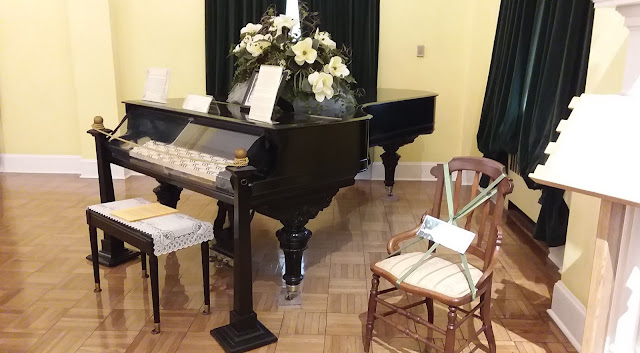 |
| 1907 Steinway Concert Grand Piano with rare von Janko keyboard. |
The nearby Carillon Tower houses more museum items and exhibits. The carillon's electronic roller plays Foster tunes daily.
The world's largest tubular bell carillon was installed in the tower in the summer of 1958 by J. C. Deagan Co., Inc of Chicago, Illinois. More than a year's time and a cost of $120,000 was required by the craftsmen to build the huge set of bells. This was the greatest single manufacturing project in the firm's 78 years history or originating and producing a variety of percussive musical instruments which are well known throughout the world.
The carillon system is composed of 97 bells, 3 sets of 32 bells each, and one high G. The largest bells are 12-1/2 ft long and weigh 426 pounds. They are supported by a massive wooden structure that measures 21 ft high, 15 ft long, and 11 ft wide.
Museum on the first floor of the Carillon tower.
| Stephen Foster composed more than 200 songs. |
The carillon played while we were there, but because of the damage, it was 'off key', but still a big thrill.
The Gift Shop is wonderful!! Two floors of art, handcrafts, jewellery, toys, folk and contemporary musical instruments, books and Stephen Foster memorabilia is available. Also homemade candy, ice cream, jams, jellies, local honey and syrup.
A local woodworker makes dulcimers and other wooden musical instruments.
A dulcimer is a type of musical string instrument. They can be very different in shape and number of strings. Different among cultures and countries.
Internet: Hammered dulcimer: free standing, frequently trapezoidal in shape, with many strings struck by handheld 'hammers'.
Fretted: three of four strings, generally played on the lap by strumming. e.g. Appalachian dulcimer, a folk instrument used in the Appalachian mountains of the U.S.
Can be tear-drop shaped and played upright with a bow, or have a banjo membrane.
Very interesting sound!
 |
| The one string can-jo's. |
 |
| These are thumb-harps made from coconut shells. |
The Stephen Foster Cultural Park is a gateway for the Suwannee River Wilderness Trail and Florida National Scenic Trail, the park offers riverside cabins, beautiful campground, cultural events, educational programs and outdoor activities.
Our next stop in the Cultural Park was the Ann Thomas River Gazebo on the banks of the Suwanee River.
| Found this little lizard on the walkway. |
| This family paddling down the Suwanee River. |
| Flood marker - wow! |
The town of White Springs is well past its heyday, but some beautiful old architecture.
| Old Telford Hotel. |
| The Visitors Centre. |
Internet: The abandoned bathhouse is all that remains of the hot springs, considered Florida;s original tourist attraction.
White Sulphur Springs was originally a sacred meeting ground for the Apalachee and Timucuan tribes. Believing that the sulphuric water had medicinal powers, the opposing tribes agreed to set aside their conflicts to drink and bathe in the mineral water without fear of attacked.
In 1835, after purchasing land along the Suwanee River, Bryant and Elizabeth Sheffield discovered the spring. Despite the fact that the sulphur-laden spring water stunk of rotten eggs, Mr Sheffield claimed that upon drinking it his nerves were calmed, his kidney troubles appeased, and his rheumatism cured.
The Sheffields built a hotel and a bathhouse and market the White Sulphur Springs as a cure-all health spa. Guests seeking treatment for everything from rashes to cancer arrived via the Suwannee River ferry. By the late 19th century the town had 14 luxury hotels and numerous boarding houses to accommodate the visitors, including some famous visitors such as Teddy Roosevelt and Henry Ford.
In 1908, the simple wooden bathhouse was upgraded to a four-story building with dressing rooms, examination and treatment rooms, and a concession stand. The circular balconies surrounded a 20 x 30-foot bathing pool cut from solid rock, where the waters maintained a temperature of 72 degrees F. A large concrete gate kept the cold waters of the river from mixing with the spring water.
By the 1930s, the popularity of the resort had dwindled. The spring, which once flowed at a rate of about 47 million gallons a day, dried up in 1990.
Despite infrequent flooding from heavy rain, it appears the sulphur waters are gone for good. Visitors to the area today can view the ruins of the old coquina bathhouse, which still stands as a reminder of White Springs' days as Florida's first tourist attraction.
This is an old photo of the 4 story bathhouse.
This is how it looks now.
| The Suwanee River at White Springs. |
| A nearby spring. |
Lake City is known as "The Gateway to Florida" because it is adjacent to the intersection of Interstate highways 10 and 75.
Internet: Lake City first began as the town of Alligator in 1821, and became the seat of Columbia County in 1832. In 1858 Alligator was incorporated and renamed Lake City. The largest American Civil War battle in Florida took place near here in teh Battle of Olustee in 1864; the Confederates won. During the Seminole Wars, several forts were established in the area. In November 1858 a railroad was completed connecting Jacksonville to Alligator, which opened the town to more commerce and passenger traffic.
The Civil War badly damaged Florida's railroads including the Florida, Atlantic and Gulf Central Railroad.
In 1874 a fire destroyed most of the wooden buildings in Lake City.
Bu the early 20th century, Lake City had become an important railroad junction. Hotel Blanche was built in 1902 as an attraction for expected tourists.
Now, the forestry products industry (turpentine, lumber, and pulpwood) has become a mainstay of the local economy.
This pristine part of Florida is a natural theme park for outdoor enthusiasts, festival goers, music lovers or those who simply want to spend a little time in a quiet, tranquil setting. Lake City has crystal-clear freshwater springs, rocking music festivals, history, culture, paddling and biking.
The historic downtown area is being rehabilitated, Hotel Blanche was being transformed into apartments, offices and retail. Found a couple of brew pubs!

| Halpatter Brewing Co. |
The Halpatter Brewing Co., is located in the old Town Hall.
A lot of the decor and furnishing of the brewery is re-purposed from the old building.

The steel grating hanging from the ceiling in the photo below, is the original fire escape from the Hotel Blanche.
Opened only 2 years, the Halpatter Brewing Co., has an award winning beer.
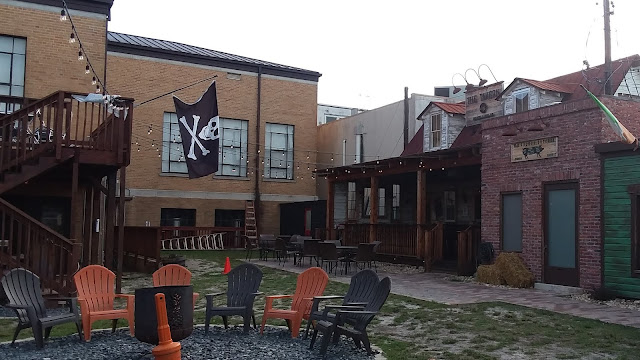 |
| The outdoor area for Halpatters and the Tavern, |
I saw several beautiful murals on buildings.
The Tavern Irish Pub and Brewery was around the corner from Halpatters, we had a beer and dinner there.
Lake Desoto was the closest, so after dinner we enjoyed a walk around it - very popular with joggers and walkers in the cool of the evening. Some ducks have homes on the banks.
This terraced amphitheatre was nice - designed for watching activities on the lake.
Back to the motel in the early evening - it had been a busy but a very interesting day.
Friday, 25 October we headed west to Live Oak, Florida in Suwannee County.
Website: If you've every wondered where "way down upon the Suwannee River" is, you'll find it right here in north central Florida's spring-fed oasis of unscathed beauty. Sandwiched between the Suwannee and Santa Fe rivers, the Live Oak region lays claim to more than 100 springs, unadulterated wilderness, rich recreational possibilities, friendly river towns, old-time festivals and intriguing historical sites.
Formally organised in 1878, Live Oak was named for a large oak tree that stood beside the first train station in the area. Railroad workers gathered at noontime to eat in the shade of the tree.
In the 1900, the lumber industry and railroads put Live oak on the map.
Suwannee County Court House built in 1904.
| To honor Stephen C Foster. |
The sidewalk had oak trees in the pavers.
We walked around the historic downtown streets of Live Oak. Stumbled on this beautiful railroad building that is now a museum.
Website: Suwannee County Historical Museum: The building that houses the museum was originally the Freight Station of the Atlantic Coastline Railroad, built in 1903. It contains exhibits and documentation that trace the history of the area.
| Next to the old railway station. |
On entering the museum, we were told that the museum was in the process of renovations and rearranging exhibits, but we were welcome to look around, only to be careful around the workers and tools.
We spent a couple of hours there! It was fascinating and we enjoyed all the exhibits - ranging from the first inhabitants from 12,000 years ago, a great telecommunications exhibit, transportation, 19th century home life, etc.
| A moonshine still. |
| The original wooden town hall clock face. The small door was to allow the hands to be moved by hand, with an arm out this 'window'. |
| Agricultural tools and equipment. |
| Typewriters and printing equipment. |
In some areas of the museum, wall exhibits had been taken down and stacked up, but we still got to see most of it. There was a great collection.
| The piano and a shelf to fit the oil lamps. |
| Modern working tools mixed in with the exhibits! |
This building was the Live Oak City Hall, Police and Fire Department and jail. It is designed on the square plan with tower and central hall with decorative elements in the Italianate style. Today it is the Suwannee County Chamber of Commerce.
| Interesting things to be seen on side streets! |
Along with its springs, trails and the Suwannee River, Live Oak is home to the Spirit of Suwannee Music Park which hosts several music festivals (approx. 600,000 guests) annually.
Website: The Spirit of the Suwannee Music Park is a one-of-a-kind music park and campground nestled on the shady banks of the historic, tea-coloured Suwannee River in North Florida. The Spirit of the Suwannee is proud to host a variety of events throughout the year. In addition to these events, the park offers live music during the week in the Music Hall and a natural amphitheatre for outdoor music festivals.
Nearby is Suwannee Springs.
At least six springs comprise Suwannee Springs, five spilling directly into the south side of the Suwannee River. The main spring flows inside a man-made wall fifteen feet high and three feet thick of limestone rock built in the late 1890s.
Once know as Suwannee Sulfur Springs:
The history of Suwannee Springs goes back to the natives, but in the mid to late 1800s it was a popular notion that sulphur and mineral springs had unique healing qualities. It became popular for resorts and sanitariums to be constructed on or next to these springs. Often the water was also bottled and sold.
Only the foundation of the bath house remains today - and some bathers, probably festival goers were having a dip in the spring.
The Suwannee Bridge can be seen further up river.
A truss bridge, built in 1931 - was part of US Highway 129, it is out of service now, but still standing. It is part of a hiking, bicycling trail, and has been colourfully decorated! It has a 160 feet (48.77 metres ) span.
Internet: The bridge was bypassed and abandoned in 1971, but remains accessible for pedestrians. The bridge retains good historic integrity. Original metal railings remain on the truss spans, and original concrete railings on the t-beam spans.
| Looking south down the Suwannee River towards the bath house ruins. |
Two blocks of Beach Street are closed off for a classic car display, food trucks, vendors, and music.
That was a big day!
Saturday, 26 October, Jim and I went on our sunrise walk to the beach. There was a waning crescent moon.
I took the next two photos of the wall on the south side of where the boardwalk amusements have been for years. There had been a go-cart track there for a long time, but had not been in operation for about a decade. This past week, machinery has been removing all the concrete from the old go-cart track. These old murals of race cars are feint and almost apparition-like. I hope they are revitalised for what ever the next phase of the area is.
| The two flights of stairs here, are the start of my morning exercise! |
Sunday morning walk to the beach:
After taking the above photo, I noticed the young man sitting on the lifeguard stand, playing his guitar.
| Rough waves pounding the Main Street Pier. |
Website: Experience a real ghost investigation with the professional a GASP Paranormal Investigators to solve the mystery of Lucille (Lucy) and other spirits at Lilian Place.
Internet: Built in 1884, Lilian Place is the oldest home on the beach side in Daytona Beach. It is a prime example of Italianate High Victorian architecture with high ceilings, wood crown moldings and heart-of-pine floors. The house also has a ‘widow’s walk which is based on a New England design which allowed the wives of whalers to watch for their husbands returning from sea. Lucille, the mystery ghost of Lilian Place has been causing mischief for over 100 years. Strange incidents have been rumoured through the years including a woman dressed in white, laughing children, and a man believed to be a famed author that was shipwrecked off the shoreline of Daytona beach in 1896, and taken to Lilian Place to recuperate.
The photo above is from the Lilian Place website - it is the front of the house. The river was the main mode of transportation when the house was built, so the front is facing the Halifax River.The historic home was purchased by the Heritage Preservation Trust in 2009. The three Halloween evenings were fund raisers for Lilian Place. The museum is open 6 days a week for tours, and other regular fundraising events are high teas, and wine tastings.
We arrived for our Paranormal Tour at sunset, and I took a few photos of the back of the house before the sun set.
 |
| Lilian Place is on the Halifax River near the Memorial Bridge still under construction. |
The maximum group size for the paranormal tour was 18. Everyone was given a K2 meter, to detect paranormal activity.
Research: The K2 EMF meter is a Electromagnetic field meter that covers frequencies from 50-20,000 Hz.
Then we wandered around the two floors of Lilian Place, looking for ghosts activity!




It was an enjoyable evening in this beautiful historic home! Two men from GASP Paranormal had a lot information, and experience with the paranormal.
Monday, 28 October, Jim and I went on our sunrise walk to the beach.
As I walked past the garden beside the water spouts, I smelled the strong scent of the lillies. I think they are Giant White Crinum Lilies or the giant white spider lily..
Jim's high school friend, Ray and his wife Margie are spending the winter in Florida and have their RV in Cocoa Beach. We met them at Barrier Jacks for an early lunch.
 |
| Jim, Ray and Margie. |
Stopped the Space View Park in Titusville on the way back.
Website: Space View Park is located less than 15 miles directly across from the launch pads. The Park is the first and only walk that honours astronauts as well as the men and women behind the scenes who helped in space exploration.
 |
| Cape Canaveral and the Vehicle Assembly Building on the horizon. |
It is an interesting park.
Back to Daytona Beach, with a quick visit to Hewitts in New Smyrna Beach.Morning work to the beach on Tuesday, 29 October, a bit of fog.
Wednesday, 30 October - walk to the beach.
| A timid crab in the sand. |

































